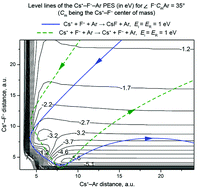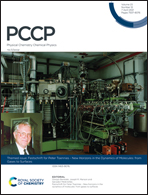Dynamics of third order direct three-body recombination of heavy ions†
Abstract
The direct three-body recombination reactions Cs+ + X− + R → CsX + R (X = F, I and R = Ar, Xe) are studied within the quasiclassical trajectory method using diabatic semiempirical potential energy surfaces, the encounters of the ions being non-central. The collision energies range between 1 and 10 eV (values typical for low temperature plasma), while the so-called delay parameter, which characterizes the delay in the arrival of the neutral atom R in relation to the time instant when the distance between the ions attains its minimum, is equal to 0 or 20%. The calculation results include the recombination excitation functions, the opacity functions, and the vibrational and rotational energy distributions of the recombination products. All the four reactions considered exhibit similar overall statistical dynamics, but each process has its own features. On the whole, for both the recombining pairs Cs+ + F− and Cs+ + I−, xenon is more effective than argon as an acceptor of excess energy from the ion pair. The rotational energy distributions of the salt molecules CsF and CsI are almost equilibrium, whereas the vibrational energy distributions are strongly non-equilibrium.

- This article is part of the themed collections: 2021 PCCP HOT Articles and Festschrift for Peter Toennies - New Horizons in the Dynamics of Molecules: from Gases to Surfaces


 Please wait while we load your content...
Please wait while we load your content...